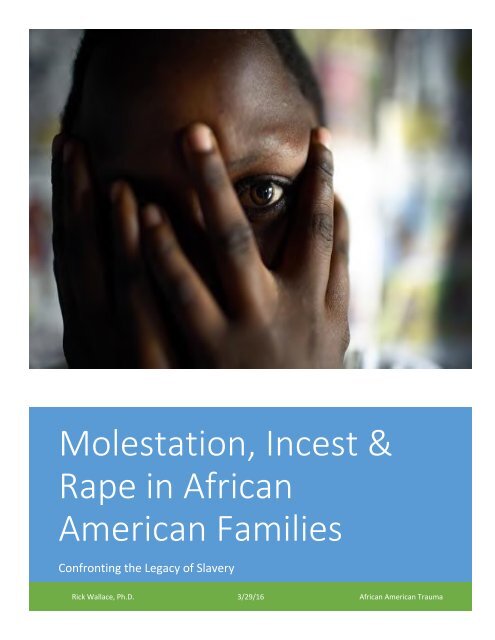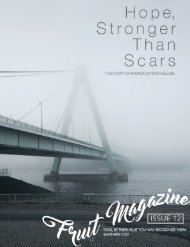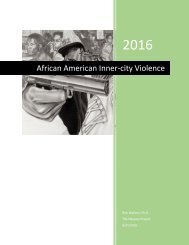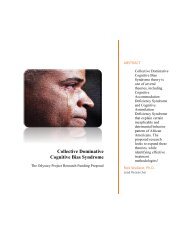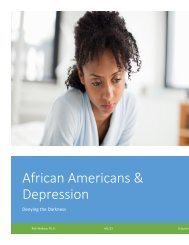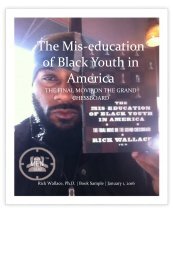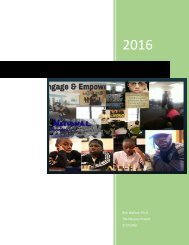Molestation, Incest and Rape in African American Families
While the subject of child molestation and incest remain a taboo topic, within the African American collective, its prevalence and impact can no longer be ignored. When perusing psychology textbooks on incest and molestation, especially the older ones, it is easy for a psychology student to develop an impression that molestation, incest and rape within the family environment is extremely rare; however, when engaging professional therapists (psychiatrists, psychologist, cognitive therapists, etc.) on the matter, it becomes obvious that this type of trauma is immensely prevalent, but that it also has an immense impact on the long-term success of the victim. The purpose of this brief treatise on this particular topic is to expand the superficial knowledge on the subject, while illuminating the manner in which this type of trauma can negatively impact the life of the victim and those within their periphery.
While the subject of child molestation and incest remain a taboo topic, within the African American collective, its prevalence and impact can no longer be ignored. When perusing psychology textbooks on incest and molestation, especially the older ones, it is easy for a psychology student to develop an impression that molestation, incest and rape within the family environment is extremely rare; however, when engaging professional therapists (psychiatrists, psychologist, cognitive therapists, etc.) on the matter, it becomes obvious that this type of trauma is immensely prevalent, but that it also has an immense impact on the long-term success of the victim. The purpose of this brief treatise on this particular topic is to expand the superficial knowledge on the subject, while illuminating the manner in which this type of trauma can negatively impact the life of the victim and those within their periphery.
Create successful ePaper yourself
Turn your PDF publications into a flip-book with our unique Google optimized e-Paper software.
<strong>Molestation</strong>, <strong>Incest</strong> &<br />
<strong>Rape</strong> <strong>in</strong> <strong>African</strong><br />
<strong>American</strong> <strong>Families</strong><br />
Confront<strong>in</strong>g the Legacy of Slavery<br />
Rick Wallace, Ph.D. 3/29/16 <strong>African</strong> <strong>American</strong> Trauma
<strong>Molestation</strong>, <strong>Incest</strong> & the <strong>African</strong> <strong>American</strong> Family<br />
The Odyssey Project<br />
Research <strong>and</strong> Advisory Council<br />
By<br />
Dr. Rick Wallace, Ph.D.<br />
Copyright © 2016 by Rick Wallace
Executive Statement<br />
While the idea of scientific research is to elim<strong>in</strong>ate the proclivity to view facts through the lens<br />
of bias, I must admit that this is a topic that challenges me like no other when it comes to bias.<br />
As a research psychologist <strong>and</strong> a cl<strong>in</strong>ical therapist, I am completely cognizant of the pathological<br />
pr<strong>in</strong>ciples <strong>and</strong> concepts of psychology that expla<strong>in</strong> the behavior of a pedophile; however, be<strong>in</strong>g<br />
the father of four daughters, <strong>and</strong> hav<strong>in</strong>g to engage the immense responsibility of protect<strong>in</strong>g them<br />
at the different stages of their lives, I am torn between what I know academically <strong>and</strong> what I am<br />
conv<strong>in</strong>ced of experientially. Although all forms of pedophilia are extremely he<strong>in</strong>ous, fatherdaughter<br />
<strong>in</strong>cest, to me, is the greatest violation of human sanctity possible, followed closely by<br />
father-son <strong>in</strong>cest.<br />
While this particular paper is meant to focus on the empirical evidence associated with <strong>in</strong>cest <strong>in</strong><br />
the <strong>African</strong> <strong>American</strong> Community. I have deemed it necessary to <strong>in</strong>dulge the need to escape<br />
academic rigidity, to some extent, for the purpose of allow<strong>in</strong>g the reader to make the connection<br />
to what they read <strong>in</strong> a manner that allows them to identify with the problem on a level that<br />
motivates them to become <strong>in</strong>volved <strong>and</strong> take action. This paper is not written with my academic<br />
peers <strong>in</strong> m<strong>in</strong>d as much as it is written with the idea of provid<strong>in</strong>g elucidation to a highly complex<br />
<strong>and</strong> pernicious force with<strong>in</strong> the black community.<br />
The black community is suffer<strong>in</strong>g <strong>in</strong> the area of unity, especially when it comes to the<br />
relationship between the black man <strong>and</strong> the black woman, <strong>and</strong> a significant portion of this<br />
dissension can be traced along the l<strong>in</strong>e of distrust to the early years of young girls who were<br />
sexually violated by men they should have been able to trust to protect them. Men who shared<br />
the same bloodl<strong>in</strong>e — <strong>in</strong> many cases, these men were their fathers, brothers <strong>and</strong> uncles. These<br />
abusive encounters led to the development of psychoneurotic behavior, such as elevated anxiety<br />
levels, issues with trust<strong>in</strong>g men, an <strong>in</strong>creased sense of distress <strong>and</strong> the development of an overall<br />
deficit <strong>in</strong> functionality.<br />
I am hop<strong>in</strong>g that this paper will bridge the gap between science, compassion <strong>and</strong> common sense.<br />
~ Dr. Rick Wallace, Ph.D., Founder-CEO, The Odyssey Project<br />
Abstract<br />
While the subject of child molestation <strong>and</strong> <strong>in</strong>cest rema<strong>in</strong>s a taboo topic with<strong>in</strong> the <strong>African</strong><br />
<strong>American</strong> collective, its prevalence <strong>and</strong> impact can no longer be ignored. When perus<strong>in</strong>g<br />
psychology textbooks on <strong>in</strong>cest <strong>and</strong> molestation, especially the older ones, it is easy for a<br />
psychology student to develop an impression that molestation, <strong>in</strong>cest <strong>and</strong> rape with<strong>in</strong> the<br />
family environment is extremely rare; however, when engag<strong>in</strong>g professional therapists<br />
(psychiatrists, psychologist, cognitive therapists, etc.) on the matter, it becomes obvious that<br />
this type of trauma is not only immensely prevalent, but that it also has an immense impact on<br />
the long-term success of the victim. The purpose of this brief treatise on this particular topic is<br />
to exp<strong>and</strong> the superficial knowledge on the subject, while illum<strong>in</strong>at<strong>in</strong>g the manner <strong>in</strong> which<br />
this type of trauma can negatively impact the life of the victim <strong>and</strong> those with<strong>in</strong> their
periphery. This is not a comprehensive exam<strong>in</strong>ation of the serious subsequent<br />
psychopathologies that occur dur<strong>in</strong>g <strong>and</strong> after <strong>in</strong>cest, molestation <strong>and</strong> rape. This paper<br />
focuses primarily on the topic as it impacts the <strong>African</strong> <strong>American</strong> collective; therefore, the<br />
mention of non-Black groups will be for the sole purpose of juxtaposed comparisons. This<br />
paper endeavors to respond to the <strong>in</strong>quiry <strong>in</strong>to the prevalence <strong>and</strong> impact of <strong>in</strong>cest,<br />
molestation <strong>and</strong> rape <strong>in</strong> <strong>African</strong> <strong>American</strong> families, the behavior that facilitates it, <strong>and</strong> the<br />
proper response.<br />
Introduction<br />
A substantial portion of the nearly 50,000 hours of research that I have conducted over the last<br />
20 years has been focused on three primary areas <strong>in</strong> which the <strong>African</strong> <strong>American</strong> collective<br />
cont<strong>in</strong>ues to struggle — education, mental illness <strong>and</strong> trauma (Wallace, 2015; Wallace, 2016;<br />
Wallace, 2016; Wallace, 2016). When it comes to the complex dynamic of trauma, not only <strong>in</strong><br />
the dist<strong>in</strong>ct ways that it is experienced by <strong>African</strong> <strong>American</strong>s, but <strong>in</strong> the numerous ways <strong>in</strong> which<br />
trauma can be transmitted <strong>in</strong>tergenerationally (Kahane-Nissenbaum, 2011; Kolk B. A., 2001;<br />
Kolk B. V., 2014; DeGruy, 2005; Akbar, 1976), it is imperative to ga<strong>in</strong> a lucid perspicacity of<br />
how the trauma impacts all of those <strong>in</strong>volved.<br />
While there are multitud<strong>in</strong>ous ways through which a person can be traumatized, without<br />
question, one of the most prevalent <strong>and</strong> devastat<strong>in</strong>g forms of trauma is physical abuse, <strong>and</strong> of all<br />
forms of physical abuse, those of a sexual nature are most nefarious, especially when the trauma<br />
is experienced at the h<strong>and</strong>s of a person who the victim should be able to trust to protect them<br />
from that very type of behavior.<br />
When I began counsel<strong>in</strong>g <strong>in</strong>dividuals, couples <strong>and</strong> families, years ago, I became overwhelmed by<br />
the number of people who eventually admitted to be<strong>in</strong>g sexually abused, <strong>in</strong> some way, as a child.<br />
This was especially true when it came to female clients. While psychology <strong>and</strong> psychiatry<br />
textbooks are more accurate <strong>in</strong> their reflection of sexual abuse of m<strong>in</strong>ors <strong>in</strong> contemporary<br />
literature, this has not always been the case. Dur<strong>in</strong>g this <strong>in</strong>itial epiphany, the textbooks were still<br />
m<strong>in</strong>imiz<strong>in</strong>g the prevalence of child sex abuse. To be fair, it was not all a part of a nefarious <strong>and</strong><br />
s<strong>in</strong>ister plan to cover up child molestation; it was more of a comb<strong>in</strong>ation of the failure of victims<br />
<strong>and</strong> their families to report the abuse. M<strong>in</strong>ors depend on their parents <strong>and</strong> other adults, who are<br />
close to them, to be their advocates — speak<strong>in</strong>g up for <strong>and</strong> defend<strong>in</strong>g them <strong>in</strong> situations <strong>in</strong> which<br />
they are unable to defend themselves. Unfortunately, many times, the person that should be their<br />
greatest advocate is actually the person who is violat<strong>in</strong>g them. The underreport<strong>in</strong>g of the abuse<br />
led to a lack of urgency <strong>in</strong> confront<strong>in</strong>g the issue on a gr<strong>and</strong> scale. Actually, <strong>in</strong> many cases, the<br />
family spent more energy <strong>and</strong> effort protect<strong>in</strong>g <strong>and</strong> defend<strong>in</strong>g the perpetrator than they did the<br />
victim.<br />
Dur<strong>in</strong>g the early 1980s, the widely accepted view on <strong>in</strong>cest, despite be<strong>in</strong>g immensely pestiferous<br />
<strong>in</strong> its assertion of mitigated impact, declared that there was no conclusive empirical data to<br />
support the theory that father-daughter <strong>in</strong>cest was capable of produc<strong>in</strong>g serious subsequent<br />
psychopathology (Kolk B. V., 2014).
What I can tell you from experience, <strong>and</strong> consult<strong>in</strong>g other professional therapists, is that females<br />
who are victims of father-daughter <strong>in</strong>cest rarely escape their traumatic experience without the<br />
development of some form of trauma-related subsequent psychopathology. In fact, these women<br />
are often significantly confused, depressed <strong>and</strong> consistently engaged <strong>in</strong> self-harm<strong>in</strong>g behaviors,<br />
<strong>in</strong>clud<strong>in</strong>g promiscuity, cutt<strong>in</strong>g themselves, illicit drug use <strong>and</strong> more.<br />
What troubles me is the fact that the textbooks that were pr<strong>in</strong>ted <strong>in</strong> the 1980s <strong>in</strong>to the early 90s<br />
did everyth<strong>in</strong>g short of endors<strong>in</strong>g <strong>in</strong>cest, offer<strong>in</strong>g an explanation that <strong>in</strong>cestuous behavior worked<br />
to dim<strong>in</strong>ish the subject's chance of psychosis <strong>and</strong> created the ability for the victim to better adjust<br />
to their external world (Henderson, 1974). Unfortunately, s<strong>in</strong>ce these books were orig<strong>in</strong>ally<br />
published, a wealth of empirical <strong>and</strong> pragmatic evidence has been produced that reveals that<br />
<strong>in</strong>cest has caused extremely devastat<strong>in</strong>g effects on the well-be<strong>in</strong>g of women.<br />
What we know now is that women who are survivors of <strong>in</strong>cest experience many of the same<br />
symptoms of soldiers who develop post-traumatic stress disorder. They have flashbacks of the<br />
traumatic event(s). They develop a higher risk of frequent nightmares. Another pronounced<br />
effect of <strong>in</strong>cest is the capriciousness as far as emotional well-be<strong>in</strong>g is concerned, with these<br />
women often vacillat<strong>in</strong>g between explosive rage <strong>and</strong> completely shutt<strong>in</strong>g down. Additionally,<br />
<strong>in</strong>cest survivors have difficulty gett<strong>in</strong>g along with others, <strong>and</strong> they struggle <strong>in</strong> the area of<br />
ma<strong>in</strong>ta<strong>in</strong><strong>in</strong>g mean<strong>in</strong>gful relationships (Kolk B. V., 2014)<br />
Although PTSD was a psychological diagnosis that was largely developed based on the behavior<br />
of post-war veterans, it should be understood that people who experience many other forms of<br />
trauma display the same symptoms (Kolk B. V., 2014). It is also important to underst<strong>and</strong> the<br />
prevalence of trauma is greater among the private sector than it is among soldiers, based solely<br />
on the number of people be<strong>in</strong>g traumatized. In fact, more accurate report<strong>in</strong>g shows that more<br />
than 12 million women <strong>in</strong> the United States have been raped, <strong>and</strong> to exacerbate the matter, more<br />
than half of female victims of rape are below the age of 15 (Kilpatrick & Saunders, 1997). What<br />
we know is that each year <strong>in</strong> the United States, three million cases of child abuse are reported,<br />
<strong>and</strong> a m<strong>in</strong>imum of one million of these cases are serious <strong>and</strong> credible enough to warrant action<br />
by child protective services <strong>and</strong> the courts (Services, 2007, 2009).<br />
While the topic of child victimization is broad <strong>and</strong> filled with an exorbitant number of<br />
<strong>in</strong>tricacies, I would like to focus on the devastat<strong>in</strong>g force of <strong>in</strong>cest, the manner <strong>in</strong> which it is<br />
often concealed by family members, the impact it has on the victims <strong>and</strong> ways that we can<br />
effectively confront this plague.<br />
Problem Statement<br />
Prior to 20 years ago, <strong>in</strong>cest among black families was rarely reported <strong>in</strong> correspondence to the<br />
prevalence of <strong>in</strong>cestuous activity with<strong>in</strong> the black community. Simply put, the <strong>in</strong>cestuous activity<br />
with<strong>in</strong> the black community was much higher than anyone was will<strong>in</strong>g to admit. S<strong>in</strong>ce slavery,<br />
<strong>in</strong>cest has been a substantial issue that has been swept under the rug, it has consistently played<br />
the role of the elephant <strong>in</strong> the room. While a constant narrative has been written <strong>in</strong> which<br />
pedophiles have been portrayed as the clean cut white, middle-aged man, or a member of the<br />
catholic clergy, the truth is that many black children don’t have to venture out of their homes to
e at risk of be<strong>in</strong>g sexually abused. As the lid is slowly unscrewed <strong>and</strong> removed, it is becom<strong>in</strong>g<br />
more apparent that sexual perversion <strong>and</strong> <strong>in</strong>cest is alive <strong>and</strong> well with<strong>in</strong> the black community. In<br />
fact, a study revealed that black women are 1.75 times more likely to have experienced Child<br />
Sexual Abuse (CSA) than white women who grew up <strong>in</strong> a two-parent household (Amodeo,<br />
Griff<strong>in</strong>, Fassler, Clay, & Ellis, 2006). What was <strong>in</strong>terest<strong>in</strong>g is the fact that a mother work<strong>in</strong>g long<br />
hours, or the presence of a stepfather, did not <strong>in</strong>crease the risk of CSA.<br />
There is a pathological behavior with<strong>in</strong> the black community that is a direct result of chattel<br />
slavery — the <strong>in</strong>explicable need for the black woman to protect the black male (Pollard-Terry,<br />
2004; Doane & Hodges, 2009). In the sense of culture, the black race is the only major racial<br />
group that functions primarily as a matriarchy, mean<strong>in</strong>g that there are more homes with children<br />
that are under the leadership of women than there are homes with families under the leadership<br />
of men (Doane & Hodges, 2009). The narrative that has endured for far too long is the idea that<br />
sexually aberrant behavior, is the result of the aberrant nature of a female led household<br />
(Moynihan, 1965). Daniel Patrick Moynihan, <strong>in</strong> his 1965 report on the black family entitled, The<br />
Negro Family: A Case for National Action, while hav<strong>in</strong>g some immensely valid po<strong>in</strong>ts,<br />
presented the erroneous assertion that the black family is the “center of the tangle of pathology,”<br />
with a weak family structure (mean<strong>in</strong>g that the family was headed by a female) (Moynihan,<br />
1965).<br />
While I will concede that the failure for the black family nucleus to susta<strong>in</strong> the proper balance<br />
<strong>and</strong> role assignment has contributed to the current state of confusion <strong>and</strong> disarray <strong>in</strong> the black<br />
collective, I must strongly suggest that we exam<strong>in</strong>e the deeper, underly<strong>in</strong>g causes for the<br />
behaviors that produced the imbalance <strong>in</strong> the first place. While the lack of male leadership has<br />
created its own set of challenges, it is not exclusively culpable for the aberrant behavior that<br />
takes place <strong>in</strong> black families.<br />
When it comes to the culture of silence with<strong>in</strong> the black community that casts a veneer over the<br />
perverted proclivities of many black men to sexually violate the children <strong>in</strong> their family, one<br />
must be will<strong>in</strong>g to trace the desire <strong>and</strong> need of the <strong>African</strong> <strong>American</strong> female to protect the black<br />
man. The <strong>African</strong> <strong>American</strong> community has an old adage that states: “Black women raise their<br />
daughters <strong>and</strong> love their sons.” What this means is that black women, dur<strong>in</strong>g slavery, developed<br />
a proclivity to rear <strong>and</strong> teach their daughters, but conversely, they sheltered <strong>and</strong> protected their<br />
sons. S<strong>in</strong>ce the arrival of the first slave ship on the shores of the North <strong>American</strong> cont<strong>in</strong>ent, there<br />
has been no person or group that has been consistently under the threat of harm <strong>and</strong> death at the<br />
level of the black man. This has lead black women to be more <strong>in</strong>cl<strong>in</strong>ed to coddle boys <strong>and</strong> more<br />
reluctant to report <strong>in</strong>cest <strong>and</strong> rape perpetuated by black men (Pollard-Terry, 2004).<br />
It is important to note here that while I am po<strong>in</strong>t<strong>in</strong>g to behavior that is highly detrimental to the<br />
effective empowerment of our youth <strong>and</strong> our people <strong>in</strong> general, I am not align<strong>in</strong>g myself with the<br />
idea of ma<strong>in</strong>stream psychology <strong>and</strong> sociology <strong>in</strong> its assertion that family structure is the sole<br />
cause of economic castration, socioeconomic dysfunctionality <strong>and</strong> aberrant, antisocial <strong>and</strong><br />
<strong>in</strong>adequate behavior among <strong>African</strong> <strong>American</strong>s. When this much gravity is placed on the family<br />
structure <strong>in</strong> determ<strong>in</strong><strong>in</strong>g the causality of the social <strong>and</strong> economic marg<strong>in</strong>ality of poor black<br />
families, the more distant cause of slavery (<strong>in</strong>clud<strong>in</strong>g its aftermath) is virtually ignored (Doane &
Hodges, 2009). When we succumb to this suggestion, the result of this type of occlusion of the<br />
traumatic reality of chattel slavery <strong>in</strong> the U.S. leads to a situation <strong>in</strong> which the <strong>African</strong> <strong>American</strong><br />
family becomes the place where the victims of racism <strong>and</strong> slavery are ambiguously adumbrated<br />
as their own victimizers. While it is imperative that we develop an underst<strong>and</strong><strong>in</strong>g of the need for<br />
accountability as it perta<strong>in</strong>s to effectively address<strong>in</strong>g the issue of <strong>in</strong>cest <strong>and</strong> rape <strong>in</strong> the <strong>African</strong><br />
<strong>American</strong> community, we must not allow ourselves to lose sight of the causality of the aberrant<br />
behavior of <strong>African</strong> <strong>American</strong> men <strong>in</strong> the first place.<br />
While the defense of a child predator should not be acceptable, under any circumstance, it is<br />
important to underst<strong>and</strong> why it is so prevalent <strong>in</strong> the <strong>African</strong> <strong>American</strong> collective. While the<br />
reluctance of Black women to report <strong>in</strong>cestuous behavior by Black men may appear to be a freepass,<br />
what it reflects most is the major distrust that black women have toward white male<br />
authority figures — which can be viewed as an extension of white slave masters <strong>and</strong> overseers.<br />
In an environment <strong>in</strong> which shar<strong>in</strong>g the illegal behavior of a loved one with the authorities can<br />
possibly lead to their death, black women balk at the opportunity <strong>and</strong> responsibility to report<br />
<strong>in</strong>cestuous behavior. This <strong>in</strong>herent circumspection of white authority that is learned from old<br />
stories shared with the family, portraits of white lynch mobs or the explanation of how that<br />
extremely light-sk<strong>in</strong>ned cous<strong>in</strong> came to be. In the eyes of the black women, she <strong>and</strong> her family<br />
have been victimized far more frequently by the white power structure than by the black men <strong>in</strong><br />
the family.<br />
It is also important to underst<strong>and</strong> that black women have been forced to come to the aid of black<br />
men who were wrongfully accused of sexual assault for years. This can best be illustrated by<br />
evaluat<strong>in</strong>g the facts associated with the Rosewood Massacre. While it is hard to believe, what<br />
was ultimately presented <strong>in</strong> the form of a motion picture, was true <strong>African</strong> <strong>American</strong> history,<br />
uncensored. This was not just another movie; it was a retell<strong>in</strong>g of a historical event. In 1923, a<br />
white woman falsely claimed that she was attacked by a black man, <strong>and</strong> that false claim led to<br />
the massacre of blacks <strong>and</strong> the complete obliteration of a black town. Unfortunately, this type of<br />
behavior among whites towards <strong>African</strong> <strong>American</strong>s has been more common than anyone really<br />
cares to admit.<br />
It has been this type of hostile behavior on the part of white authority figures, conjo<strong>in</strong>ed with<br />
other underly<strong>in</strong>g factors that has led to an elevated level of distrust that makes it difficult for<br />
black women to report <strong>in</strong>cest to the authorities.<br />
It has also been postulated <strong>and</strong> hypothesized that silent condonation of <strong>in</strong>cest with<strong>in</strong> the black<br />
family can be contributed to a developed behavior dur<strong>in</strong>g slavery to silently condone the liaisons<br />
between white fathers (slave masters <strong>and</strong> overseers) who saw their brown reflections <strong>in</strong><br />
daughters they conceived with black slaves — yet, choos<strong>in</strong>g to procreate with their brown<br />
offspr<strong>in</strong>g. It has been suggested that it became more psychologically plausible for <strong>African</strong><br />
<strong>American</strong> women that such liaisons could also occur between the black father <strong>and</strong> his female<br />
progeny (Fenton, 2012).<br />
With that be<strong>in</strong>g said, there is no excuse for not hold<strong>in</strong>g the black men who commit these<br />
atrocious acts responsible for their behavior.
The Dangers <strong>and</strong> Consequences of <strong>Incest</strong> <strong>and</strong> <strong>Rape</strong><br />
Although early textbooks that explored the impact of father-daughter <strong>in</strong>cest, suggested that there<br />
was m<strong>in</strong>imal risk of develop<strong>in</strong>g subsequent psychopathologies, we now know that, at the very<br />
least, the victims of <strong>in</strong>cest are likely to develop psychoneurosis, which has the capacity to<br />
immensely limit their ability to function <strong>in</strong> society.<br />
Fortunately, there is a grow<strong>in</strong>g wealth of empirical data that suggests that adults who were<br />
abused as kids do not have an <strong>in</strong>creased proclivity to behave violently aga<strong>in</strong>st their own progeny<br />
(Staff, 2016; Whitener, 2015). The f<strong>in</strong>d<strong>in</strong>gs of this large-scale, long-term study of child abuse<br />
contradict certa<strong>in</strong> aspects of the long-st<strong>and</strong><strong>in</strong>g “cycle of violence” theory, which suggests that a<br />
child who is abused is more likely to abuse their children than a person who was not abused as a<br />
child. However, we still have to underst<strong>and</strong> how this behavior impacts us as a group.<br />
The dis<strong>in</strong>tegrat<strong>in</strong>g relationship between <strong>African</strong> <strong>American</strong> women <strong>and</strong> <strong>African</strong> <strong>American</strong> men<br />
has been a hotly debated subject for a number of years, with an almost <strong>in</strong>nate distrust of Black<br />
men by Black women be<strong>in</strong>g at the core of the discussion.<br />
I remember hav<strong>in</strong>g a talk with a close female friend nearly four years ago. The topic was the use<br />
of the term “bitter black woman.” Dur<strong>in</strong>g this time, despite be<strong>in</strong>g a staunch defender of the honor<br />
of the black woman despite her consistent hostile behavior toward the black man, I have become<br />
frustrated with the level of what I considered to be the contempt of the black woman, aimed at<br />
the black man. The response that I received from this person, who functions as a counselor for<br />
traumatized <strong>African</strong> <strong>American</strong> women, speaks emphatically to the issue here:<br />
“You have to be aware of the underly<strong>in</strong>g cause of the m<strong>in</strong>dset that produces this<br />
seem<strong>in</strong>gly <strong>in</strong>herent hostility toward black men. There is no person on the face of the earth<br />
who has experienced the level of ab<strong>and</strong>onment that the black woman has. No person has<br />
experienced <strong>in</strong>cest <strong>and</strong> rape at the level of the black woman. No woman has been driven<br />
to defend a man who, <strong>in</strong> turn, emotionally emaciates them like the black woman. No<br />
woman has been forced to raise the progeny of a man who left her to fulfill the<br />
responsibility of parent<strong>in</strong>g on her own like the black woman. Rick, she is angry because<br />
she is alone <strong>and</strong> hurt<strong>in</strong>g.”<br />
What I do not <strong>in</strong>tend for this paper to do is take the traditional path of <strong>in</strong>cit<strong>in</strong>g emotional<br />
responses that lead to noth<strong>in</strong>g but more confusion <strong>and</strong> frustration. In the process of<br />
acknowledg<strong>in</strong>g that there is a problem with <strong>in</strong>cestuous behavior <strong>in</strong> black families, there must be<br />
a focused <strong>and</strong> strategic plan of action. We must be will<strong>in</strong>g to address the psychosocial <strong>and</strong><br />
behavioral sequelae of this phenomenon with<strong>in</strong> the black family structure (Thornton & MSW,<br />
1986).<br />
Treatment <strong>and</strong> Effective Intervention<br />
To this po<strong>in</strong>t, very little attention has been given to <strong>in</strong>cest among black families <strong>and</strong> the attendant<br />
treatment issues. Herman <strong>and</strong> Hirschman (Herman & Hirschman, 1981) suggested that part of<br />
the problem may rest <strong>in</strong> the fact that society postulates that <strong>in</strong>cest is not a prevalent issue <strong>in</strong> black<br />
families; however, while this belief may expla<strong>in</strong> the lack of proactivity from non-blacks, it does
not account for the <strong>in</strong>ability of black families to address what they know to be an issue. Another<br />
question that must be answered is: Are sanctions aga<strong>in</strong>st <strong>in</strong>cestuous behavior be<strong>in</strong>g strictly<br />
enforced <strong>in</strong> black families. And yet, another consideration is that the omission of any discussion<br />
surround<strong>in</strong>g <strong>in</strong>cest among <strong>African</strong> <strong>American</strong>s is directly <strong>in</strong>fluenced by the misconceptions <strong>and</strong><br />
myths associated with black family <strong>in</strong>teractions <strong>and</strong> psychopathology (Lyles & Carter, 1982;<br />
Carter, 1978). When it comes to the exam<strong>in</strong>ation of <strong>in</strong>cest <strong>in</strong> the black family, it can be easy for<br />
non-black researchers to view this behavior through the paradigm that is preoccupied with the<br />
sexual prowess of the black man, focus<strong>in</strong>g on a belief that can be traced as far back as the 16 th<br />
century, when black men were described by Englishmen as be<strong>in</strong>g unrestra<strong>in</strong>ed <strong>in</strong> their sexual<br />
lusts (Staples, 1978).<br />
Characteristics of <strong>Incest</strong>uous <strong>Families</strong><br />
One area <strong>in</strong> which we must improve is be<strong>in</strong>g able to identify <strong>in</strong>cestuous situations. In order for<br />
this to happen, we must underst<strong>and</strong> the basic characteristics of an <strong>in</strong>cestuous family.<br />
The Family (In General)<br />
Character disordered family (the axiological system is out of alignment, lack<strong>in</strong>g the core<br />
values to guard aga<strong>in</strong>st malevolent behavior)<br />
Act<strong>in</strong>g out behavior<br />
Poor impulse control (The <strong>in</strong>ability to control impulses is a key element <strong>in</strong> the<br />
development of the proclivity to molest children.)<br />
The proclivity to use behavior as a substitute for verbal communication (The <strong>in</strong>ability to<br />
effectively express feel<strong>in</strong>gs <strong>and</strong> thoughts coherently)<br />
Increased risk of family violence (With violence be<strong>in</strong>g a chosen mechanism for settl<strong>in</strong>g<br />
disputes <strong>and</strong> ma<strong>in</strong>ta<strong>in</strong><strong>in</strong>g authoritative control)<br />
The members of the family tend to foster narcissistic, self-absorbed personalities (A<br />
family full of people who are primarily concerned only about themselves)<br />
Appearance of respectability<br />
A dem<strong>and</strong> of respect by the hierarchy (Primarily the parents)<br />
Family unity is usually highly galvanized, although this is normally accomplished<br />
through pathological bonds, creat<strong>in</strong>g a strong tendency to reconnect when separate.)<br />
The presence of extremely rigid boundaries <strong>and</strong> roles, especially along the l<strong>in</strong>es of sex;<br />
however, the generational l<strong>in</strong>es <strong>and</strong> roles a generally obscured.<br />
Extremes <strong>in</strong> expectations <strong>and</strong> behaviors (either very permissive, or highly repressive)<br />
around family values <strong>and</strong> sexual conduct<br />
The Abusive Parent<br />
<br />
<br />
<br />
<br />
<br />
Hyper-controll<strong>in</strong>g <strong>and</strong> overly restrictive<br />
Discipl<strong>in</strong>es members <strong>in</strong> the family excessively<br />
Compliant women<br />
Struggles with impulse control<br />
The high <strong>in</strong>cidence of alcohol use (often us<strong>in</strong>g alcohol as a form of self-medication)
Deny any accusations emphatically<br />
The tendency to project blame toward the children <strong>in</strong> the family <strong>and</strong> the spouse<br />
Tends to avoid responsibility by m<strong>in</strong>imiz<strong>in</strong>g the severity of their behavior<br />
May acknowledge the consequences of their behavior, but will attribute them to an<br />
external force, <strong>and</strong> not themselves<br />
Non-abusive Parent<br />
Type 1: Passive, Dependent Personality (most common)<br />
<br />
<br />
<br />
<br />
<br />
Reverses role with the child (with the child function<strong>in</strong>g more like the adult <strong>in</strong> the<br />
relationship)<br />
Their dependency of the abusive spouse requires that they ignore any signs of their<br />
spouse abus<strong>in</strong>g their child, tend<strong>in</strong>g to believe the spouse over the child.<br />
Highly <strong>in</strong>capacitated or frequently away from the home<br />
Compla<strong>in</strong>s about fatigue <strong>and</strong> the lack of energy<br />
Depressive<br />
Type 2: Strong, Independent Personality<br />
<br />
<br />
<br />
Less dependent on mate<br />
Possesses the verbal ability to express ambivalence toward child <strong>and</strong> rage toward a<br />
spouse<br />
Throws spouse out<br />
* (Gaye, 1983; Thornton & MSW, 1986)<br />
Develop<strong>in</strong>g Effective Treatment <strong>and</strong> Intervention Strategies <strong>and</strong> Plans<br />
When exam<strong>in</strong><strong>in</strong>g the corollaries of <strong>in</strong>cest <strong>in</strong> <strong>African</strong> <strong>American</strong> families there are some common<br />
pathologies that must be addressed, but first the automatic response upon discover<strong>in</strong>g an<br />
<strong>in</strong>cestuous situation is to take the necessary action to get the abusive parent out of the home.<br />
Upon gett<strong>in</strong>g the perpetrator out of the home, we must then engage the dynamic responsible for<br />
creat<strong>in</strong>g an environment where such a he<strong>in</strong>ous act could take place. The development of an<br />
<strong>in</strong>cestuous environment is not an abstract or <strong>in</strong>explicable occurrence — regardless of how many<br />
family members profess that they had no idea of what was tak<strong>in</strong>g place. There is a dist<strong>in</strong>ct<br />
pathology that should lead to questions <strong>and</strong> exam<strong>in</strong>ations of the situation (Thornton & MSW,<br />
1986).<br />
Some pathological behaviors associated with the foster<strong>in</strong>g of an <strong>in</strong>cestuous environment <strong>in</strong>clude<br />
role <strong>and</strong> boundary confusion, poor impulse control — function<strong>in</strong>g as an expression of the<br />
offender’s emotional dependency <strong>and</strong> unmet physical <strong>and</strong> emotional needs. It is surpris<strong>in</strong>g that <strong>in</strong><br />
most cases, neither parent admits to be<strong>in</strong>g abused as a child, but they both tend to share a chaotic<br />
background, especially <strong>in</strong> their childhood years — lack<strong>in</strong>g healthy male <strong>and</strong> female role models.<br />
Another area of difficulty <strong>in</strong> effectively confront<strong>in</strong>g this issue is the <strong>in</strong>herent distrust between<br />
<strong>African</strong> <strong>American</strong>s <strong>and</strong> Child Protective Services. Without the consistent, appropriate <strong>and</strong> timely
<strong>in</strong>vestigation of <strong>in</strong>cestuous situations by CPS, it is virtually impossible to prescribe effective<br />
treatment programs <strong>and</strong> plans. The reason that immediate treatment is important is that fail<strong>in</strong>g to<br />
address the issue will place another generation at risk of liv<strong>in</strong>g out that same behavior, <strong>and</strong> on a<br />
gr<strong>and</strong>er scale, it produces another generation of traumatized <strong>African</strong> <strong>American</strong>s that are<br />
<strong>in</strong>capable of function<strong>in</strong>g at a high enough level to raise themselves out of the pit of despair.<br />
As far as the victim is concerned, the idea is to assist them with overcom<strong>in</strong>g their pathological<br />
dependency upon the family (especially the abuser), while help<strong>in</strong>g them develop healthy <strong>and</strong><br />
appropriate peer relationships, improv<strong>in</strong>g their self-concept (self-image) — ultimately lead<strong>in</strong>g to<br />
elevated self-esteem.<br />
We must also engage the family, because although other members may have not been directly<br />
victimized, they can still be traumatized, or they could develop the proclivity to victimize others.<br />
Conclusion<br />
<strong>Incest</strong> <strong>and</strong> child molestation with<strong>in</strong> the black collective has been met with silent condonation for<br />
far too long. As a race that has yet to confront a number of mental disorders, such as depression,<br />
bi-polar disorder <strong>and</strong> numerous dissociative disorders, we cannot allow our lethargy <strong>and</strong><br />
<strong>in</strong>sensitivity to the reality of <strong>in</strong>cest to constantly produce women <strong>and</strong> men who are suffer<strong>in</strong>g<br />
from psychoneurosis at vary<strong>in</strong>g levels. While we fight to develop more effective ways to<br />
<strong>in</strong>tervene <strong>and</strong> treat this epidemic, we have to underst<strong>and</strong> that prevention will prove significantly<br />
more efficacious <strong>in</strong> right<strong>in</strong>g the ship.<br />
We must develop a mentality that places great gravity on the protection of our children, <strong>and</strong> we<br />
must respond with passion <strong>and</strong> commitment to the need to solve this enigmatic issue.<br />
Additionally, while we must work hard to save our youth, we cannot lose sight of the fact that<br />
many of our women are suffer<strong>in</strong>g from the direct psychological <strong>and</strong> neurological effects of<br />
<strong>in</strong>cest, <strong>and</strong> <strong>in</strong>stead of throw<strong>in</strong>g them a lifel<strong>in</strong>e, we judge them, we ostracize them or we simply<br />
pretend that they don’t exist. It is time that we own this legacy of slavery <strong>and</strong> respond to it <strong>in</strong> a<br />
manner that helps the collective to heal.<br />
By<br />
Dr. Rick Wallace, Ph.D.
Other Resources by Dr. Rick Wallace <strong>in</strong>clude:<br />
The Mis-education of Black Youth <strong>in</strong> America<br />
The Invisible Father: Revers<strong>in</strong>g the Curse of a Fatherless Generation<br />
When Your House is Not a Home<br />
Renew<strong>in</strong>g Your M<strong>in</strong>d<br />
Visit The Odyssey Project Site Here<br />
The Bluepr<strong>in</strong>t 1.0<br />
Special Education Position Paper<br />
Racial Trauma & <strong>African</strong> <strong>American</strong>s<br />
Over the past 20 years, Dr. Wallace has <strong>in</strong>vested more than<br />
48,000 hours of research <strong>in</strong>to underst<strong>and</strong><strong>in</strong>g the scientific<br />
implications of white supremacy <strong>and</strong> how they have directly<br />
impacted <strong>African</strong> <strong>American</strong>s <strong>in</strong> all n<strong>in</strong>e areas of human<br />
activity, which <strong>in</strong>clude economics, education, enterta<strong>in</strong>ment,<br />
labor, law, politics, religion, sex <strong>and</strong> war. He has spent a<br />
substantial amount of time attempt<strong>in</strong>g to answer the question<br />
of why blacks seem <strong>in</strong>capable of overcom<strong>in</strong>g the barrier of<br />
racism despite the fact that the solution has been placed<br />
before them.<br />
The preponderance of the evidence that Dr. Wallace has<br />
exam<strong>in</strong>ed has provided him with a lucid perspicacity of the complex dynamic at play — a<br />
dynamic that <strong>in</strong>cludes psychological, sociological, economic <strong>and</strong> political oppression<br />
that is executed through multitud<strong>in</strong>ous pernicious mach<strong>in</strong>ations. He has used this<br />
<strong>in</strong>formation to develop what he calls The Black Community Empowerment Bluepr<strong>in</strong>t<br />
1.0. This bluepr<strong>in</strong>t is a comprehensive strategy that addresses every area of concern for<br />
the black collective <strong>in</strong> great detail. Dr. Wallace has also dissem<strong>in</strong>ated his f<strong>in</strong>d<strong>in</strong>gs <strong>in</strong> a<br />
number of literary works, <strong>in</strong>clud<strong>in</strong>g his latest book, The Mis-education of Black Youth <strong>in</strong><br />
America.<br />
Currently, Dr. Wallace is mov<strong>in</strong>g <strong>in</strong>to the second phase of his research, transition<strong>in</strong>g<br />
from <strong>in</strong>ductive research to deductive research for the purpose of advanc<strong>in</strong>g <strong>and</strong>
<strong>in</strong>troduc<strong>in</strong>g certa<strong>in</strong> scientific theories associated with the <strong>African</strong> <strong>American</strong> experience.<br />
To this date, Dr. Wallace’s research has proven to be immensely valuable, as he develops<br />
social programs to counter external <strong>in</strong>fluences, lectures to <strong>African</strong> <strong>American</strong>s across the<br />
nation <strong>and</strong> develops a comprehensive bluepr<strong>in</strong>t capable of facilitat<strong>in</strong>g<br />
the complete elevation <strong>and</strong> empowerment of <strong>African</strong> <strong>American</strong>s, as well as the complete<br />
diaspora <strong>in</strong> time, but the cost of research can be quite exorbitant, especially when he is<br />
<strong>in</strong>vest<strong>in</strong>g between 55-85 hours per week.<br />
To this po<strong>in</strong>t, all fund<strong>in</strong>g has been covered by Dr. Wallace himself. He is currently<br />
seek<strong>in</strong>g research fund<strong>in</strong>g, but due to the specific focus of his research, traditional<br />
channels, such as government, academic <strong>and</strong> private grants are not an option. While he<br />
currently has a couple <strong>in</strong>terested sponsors, both of them are non-blacks, which speaks<br />
volumes. While Dr. Wallace has committed to proceed<strong>in</strong>g at all cost, the support of the<br />
community <strong>and</strong> people he is fight<strong>in</strong>g for will prove highly beneficial <strong>in</strong> multitud<strong>in</strong>ous<br />
ways.<br />
To contribute to his work through The Odyssey Project, Click here!
Bibliography<br />
Akbar, N. (1976). Cha<strong>in</strong>s <strong>and</strong> Images of Psychological Slavery. Tallahassee, FL: M<strong>in</strong>d<br />
Publications & Associates, Inc. .<br />
Amodeo, M., Griff<strong>in</strong>, M. L., Fassler, I. R., Clay, C. M., & Ellis, M. A. (2006). Child Sexual<br />
Abuse Among Black Women <strong>and</strong> White Women form Two-Parent <strong>Families</strong>. Child<br />
Maltreatment.<br />
Carter, J. H. (1978). Treat<strong>in</strong>g Black Patients: The Risksof Ignor<strong>in</strong>g Critical Social Issues.<br />
Hospital of Cummunity Psychiatry.<br />
DeGruy, J. (2005). Post Traumatic Slave Syndrome: America's Legacy of Endur<strong>in</strong>g Injury <strong>and</strong><br />
Heal<strong>in</strong>g. Portl<strong>and</strong>, OR: Uptone Press.<br />
Doane, J., & Hodges, D. (2009). Tell<strong>in</strong>g <strong>Incest</strong>: Narratives of Dangerous Remember<strong>in</strong>g from<br />
Ste<strong>in</strong> to Sapphire. The University of Michigan Press.<br />
Fenton, Z. E. (2012). An Essay on Slavery's Hidden Legacy: Social Hysterical <strong>and</strong> Structural<br />
Condonation of <strong>Incest</strong>. Howard Law Journal.<br />
Gaye, S. (1983). Community-based Child Sexual Abuse Treatment Program. Wake County Drug<br />
Treatment Center.<br />
Henderson, D. J. (1974). "<strong>Incest</strong>". Baltimore, MD: Williams & Wilk<strong>in</strong>s.<br />
Herman, J., & Hirschman, L. (1981). <strong>Families</strong> at Risk for Father-Daughter <strong>Incest</strong>. Am J.<br />
Pyschiatry.<br />
Kahane-Nissenbaum, M. C. (2011). Explor<strong>in</strong>g Intergenerational Transmission of Trauma <strong>in</strong><br />
Third Generation Holocaust Survivors. University of Pennsylvania Scholarly Commons.<br />
Kilpatrick, D. G., & Saunders, B. E. (1997). Prevalence <strong>and</strong> Consequences of Child<br />
Victimization: Results from the National Survey of Adolescents. National Crime Victims<br />
Research <strong>and</strong> Treatment Center, Department of Psychiatry <strong>and</strong> Behavioral Sciences,<br />
Medical University of South Carol<strong>in</strong>a.<br />
Kolk, B. A. (2001). Explor<strong>in</strong>g the Nature of Traumatic Memory: Comb<strong>in</strong><strong>in</strong>g Cl<strong>in</strong>ical Knowledge<br />
with Laboratory Methods. Trauma <strong>and</strong> Cognitive Science Haworth Press, Inc.<br />
Kolk, B. V. (2014). The Body Keeps the Score. New York: Pengu<strong>in</strong> Publishers.<br />
Lyles, M. R., & Carter, J. H. (1982). Myths <strong>and</strong> Strengths of the Black Family: A Historical <strong>and</strong><br />
Sociological Contribution to Family Therapy. National Medical Association.<br />
Moynihan, D. P. (1965). The Negro Family: A Case for National Action. Wash<strong>in</strong>gton D.C.:<br />
Office of Policy Plann<strong>in</strong>g, The U.S. Department of Labor.
Pollard-Terry, G. (2004, July 4). For <strong>African</strong> <strong>American</strong> <strong>Rape</strong> Victims, A Culture of Silence. Los<br />
Angeles Times.<br />
Services, U. S. (2007, 2009). Child Maltreatment. Admiistration of Children, Youth <strong>and</strong><br />
<strong>Families</strong>.<br />
Staff, E. (2016). Child Abuse <strong>and</strong> Neglect Statistics. <strong>American</strong> Humane Association.<br />
Staples, R. (1978). Mascul<strong>in</strong>ity <strong>and</strong> Race: The Dual Dilemma of Black men. Social Issues.<br />
Thornton, C. I., & MSW, J. H. (1986). Treatment Considerations with Black <strong>Incest</strong>uous<br />
<strong>Families</strong>. Journal of National Medical Association .<br />
Wallace, R. (2015). The Miseducation of Black Youth <strong>in</strong> America: The F<strong>in</strong>al Move on the Gr<strong>and</strong><br />
Chessboard. Etteloc Publish<strong>in</strong>g.<br />
Wallace, R. (2016). "Special Education" as a Mechanism for the Mis-education of <strong>African</strong><br />
<strong>American</strong> Youth. The Odyssey Project .<br />
Wallace, R. (2016). Epigenetics & Psychology: The Genetic Intergenerational Transmission of<br />
Trauma. The Odyssey Project.<br />
Wallace, R. (2016). Racial Trauma & <strong>African</strong> <strong>American</strong>s. The Odyssey Project.<br />
Whitener, B. (2015). Adults Physically Abused as Children Not More Likely to Physically<br />
Abused Their Children. National Institutes of Health.


